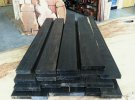can anyone shed more light on where "black and white" ebony falls in mix?
According to this link, it is softer, 51 lbs per cubic foot, it would float.
http://www.wood-database.com/lumber-identification/hardwoods/black-and-white-ebony/
Bagpipes made of blackwood are polished to a sheen and oiled from time to time down the bore like all woodwind instruments. But they are hard and stable with no exterior finish at all. Ebony pipes are all sealed on the exterior which is because they will otherwise collect moisture and humidity from the outside. I am told by makers that some kind of laquer is always necessary on ebony to stabilize it.
Thanks for sharing that info, very interesting to me. I looked up the density of laquer, it is 56 pounds per cubic foot.. lighter than water. So its being used as a sealant. I would have thought oil would work as well. Since you oil the bore of ebony pipes, I wonder why it would not work to oil the outside, like we do with knives?
fwiw, the density of mineral oil is 50 lbs per cu ft, very close to lacquer. Some of us also use waxes on our woods. I mention these just as sealants, although it seems to me that Ebony is very durable, even uncoated, unoiled, unstabilized.
One reason I think Ebony is and was popular as a knife handle is because of its high density/weight. Being heavier than water, it resists rotting. If you look at this chart you will see the only wood that compares in density to Ebony is Lignum Vitae (and African Blackwood which is not listed there). Neither, Oak, Ash, Elm, Yew, Cherry or Walnut are even close, those being European woods that might have been used without importing from Africa. And there definitely are knives with oak handles, which is impressively durable in its own right, even though most Oaks have a density of less than 50 pounds per cubic foot.
http://www.engineeringtoolbox.com/wood-density-d_40.html
you will see Ebony is denser that just about everything else
Is today's modern Ebony still superior to AB?
AB is denser than Ebony, hence superior in hardness. But maybe you are asking which is blacker? In any case, even ebony with chocolate stripes is dense and durable. Also true for Blackwood with chocolate swirls.
























